
The Tempest by Izadora Weiss.
© K. Mystkowski. (Click image for larger version)
Baltic Dance Theatre
The Tempest
Gdansk, Baltic Opera House
24 May 2015
www.baltyckiteatrtanca.pl
Dance Tabs has regularly been invited to review Baltic Dance Theatre’s performances ever since the husband and wife team of Marek and Izadora Weiss moved from Warsaw in 2010 to direct Gdansk Opera House’s productions. In place of a small ballet ensemble, the theatre now has a contemporary dance company of 20, along the lines of Nederlands Dans Theatre.
Izadora Weiss has been building Baltic Dance Theatre’s repertoire with her own creations, gradually adding works by other choreographers, including Jiri Kylian. After seeing her early attempts, he had invited her to NDT’s headquarters in The Hague to spend time with his company as a choreographic trainee. She is now forging her own contemporary style, based on her classical ballet training and Kylian’s sculptural use of the body, to create narrative works for her choice of dancers.
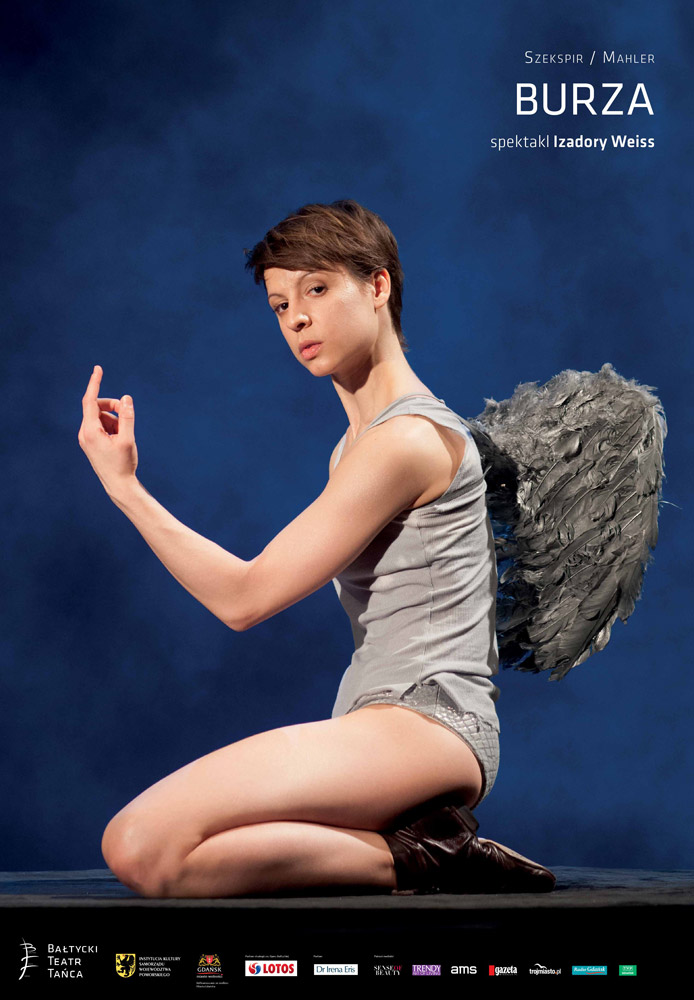
© K. Mystkowski. (Click image for larger version)
Her latest evening-length piece, The Tempest, is her third work based on a Shakespeare play (following Romeo and Juliet and A Midsummer Night’s Dream). Shakespeare is a big name in Gdansk. There’s an annual Shakespeare Festival and a new Shakespeare Theatre, finally completed in September last year. Built on the site of Gdansk’s first public playhouse, which was possibly modelled on the early 17th century Fortune Playhouse in London, it contains a square wooden theatre with three galleries within an impressive modern black brick structure. (The architect was Renato Rizzi, the funds came from the European Union and local government.) British drama companies have already performed there, just as English travelling players used to do in Gdansk in the 17th century. Professor Jerzy Limon at the local university believes that Shakespeare himself may have acted in the Baltic seaport.
Weiss’s The Tempest has its seven performances this season not in the Shakespeare Theatre but in the city’s modest Opera House, holding some 470 spectators. There is no fly tower, so the simple set by Hanna Szymczak, consisting of wooden panels, is moved by performers and stage hands, making it suitable for touring. Weiss does not assume that audiences will be familiar with Shakespeare’s play, so she provides a scenario with the programme. Since it was in Polish at the premiere, I made my own interpretation of what I saw, relying on the play, which meant I was sometimes baffled by her adaptation of the story. I was subsequently given a translation in English that helped identify unfamiliar events.
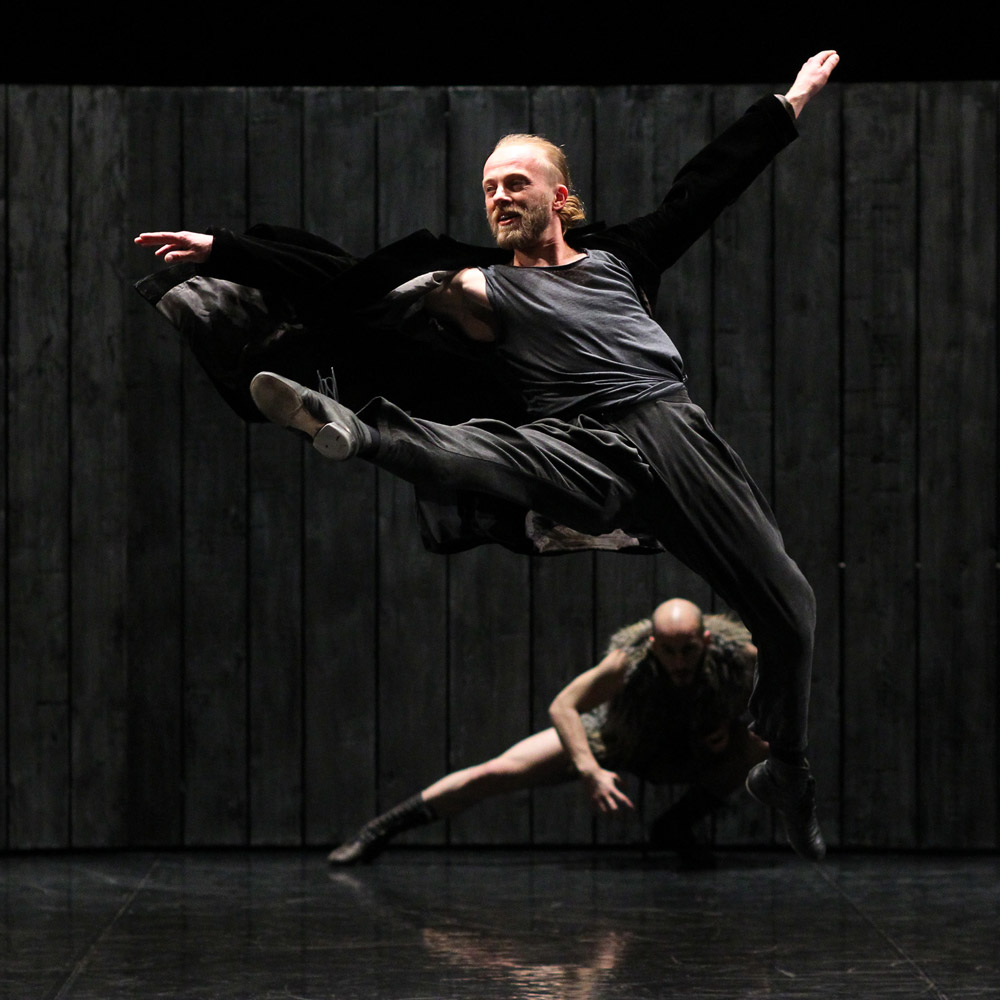
The Tempest by Izadora Weiss.
© K. Mystkowski. (Click image for larger version)
Weiss found Mahler’s First Symphony (in a recording conducted by Leonard Bernstein) ideal for her purpose, interspersing its four movements with the sound of wind and adding the adagio from Mahler’s Fifth Symphony as a conclusion. An innately musical choreographer, she seems to have put Kylian’s frequent juxtaposition of contrasting composers behind her.
She sees Prospero as an artist seeking a life of solitude away from the distractions of society, rather than as a resentful exile usurped by his brother. At the start, Filip Michalak as Prospero enters to the sound of howling wind, carrying a small girl in his arms. The wooden panels close around them, confining them to an island asylum. Prospero has apparently brought five nymphs with them to provide Miranda with friends: the girl gang includes Ariel, androgynous-looking Tura Gomez Coll, who is their ringleader.
But before they enter to play with teenage Miranda (Naya Monzon Alvarez), there is a strange encounter to the luminous opening of the First Symphony between Prospero and woman in a short gold dress and very high heels (Elzbieta Czajkowska-Klos). It seems she is Juno, Prospero’s fickle muse and erotic fantasy – a counterpart to the sorceress Sycorax, Caliban’s mother, whose ghost torments Prospero. Perhaps both are figments of Prospero’s overheated imagination, womanless in his isolation.
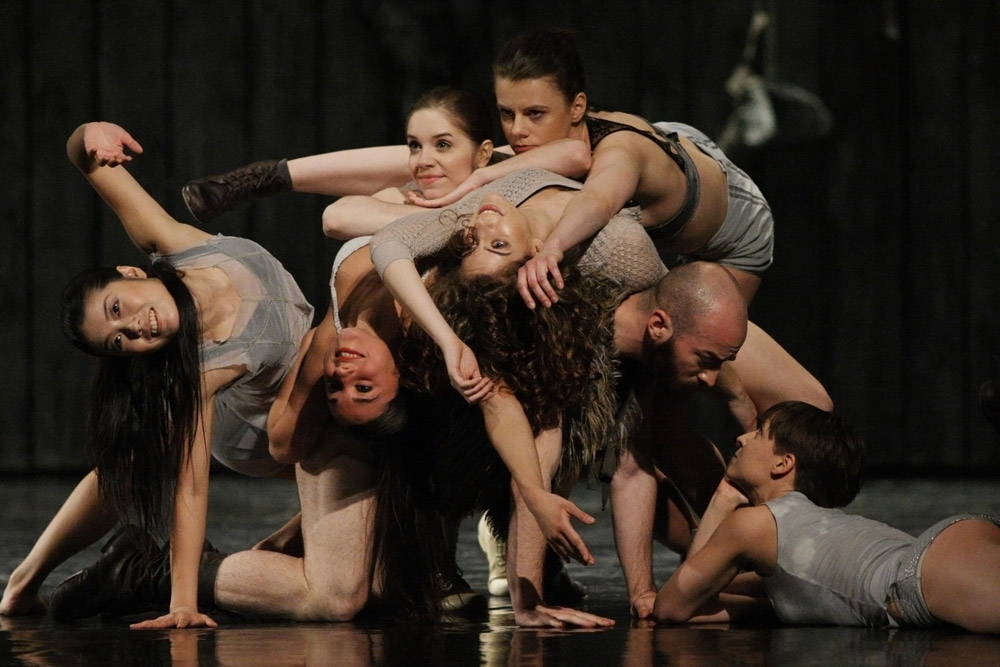
The Tempest by Izadora Weiss.
© K. Mystkowski. (Click image for larger version)
The high-spirited choreography for the naughty nymphs, set to Mahler’s spring-time first movement, is very engaging. Led by wild and impertinent Ariel, they gambol and tumble, thrusting their hips, pounding their feet and fluttering their arms. When Miranda joins in, she is more reflective, curving her torso inwards in moves the others imitate They all treat Caliban (Joel Mesa Gutierrez) as if he were a pet animal, piling onto his back or provoking him with taunting gestures.
Miranda is evidently curious about Caliban’s sexuality. She removes his shaggy waistcoat and let him take off her shoes, but before anything further can happen, Prospero soars in on a wire, showing off to his captive admirers. Apparently, since this is not true magic but a theatrical trick, the wings that the nymphs and Ariel strap on their backs are meant to be crude props. Prospero is an ineffective magician who can’t make his subjects fly. As the first movement ends on cuckoo-call notes, Ariel stamps her foot and defies him in anger.
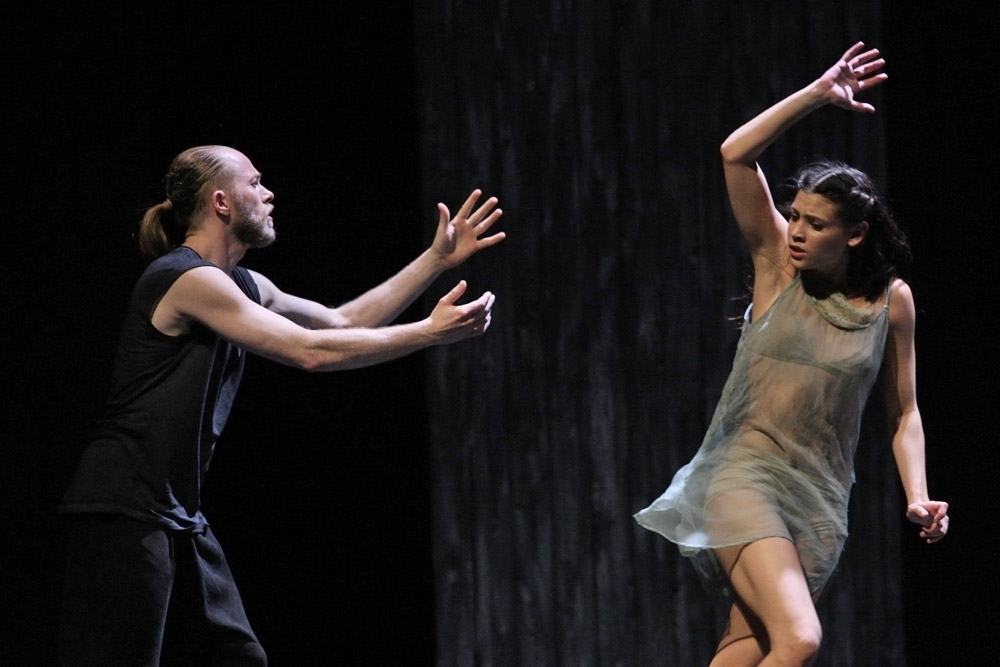
The Tempest by Izadora Weiss.
© K. Mystkowski. (Click image for larger version)
In the second movement, Miranda will defy her father for continuing to treat her as a child. At first she accepts being cradled in his arms and enjoys being swung around him. Meanwhile, her girlfriends continue teasing Caliban to Mahler’s jolly folk tunes, to the point where I started wondering whether the story would ever develop.
But then red-haired Sycorax (Agnieska Wojciechowska) makes her appearance in a scarlet tube-dress, channeling Martha Graham in murderess mode. Sycorax is a vengeful spirit, returning from the dead to protect her abused son. She is so outraged by Prospero mocking Caliban in his duet with Juno that she puts a curse on the island’s inhabitants. Misery reigns, sending Miranda into a lunging solo of lonely despair.
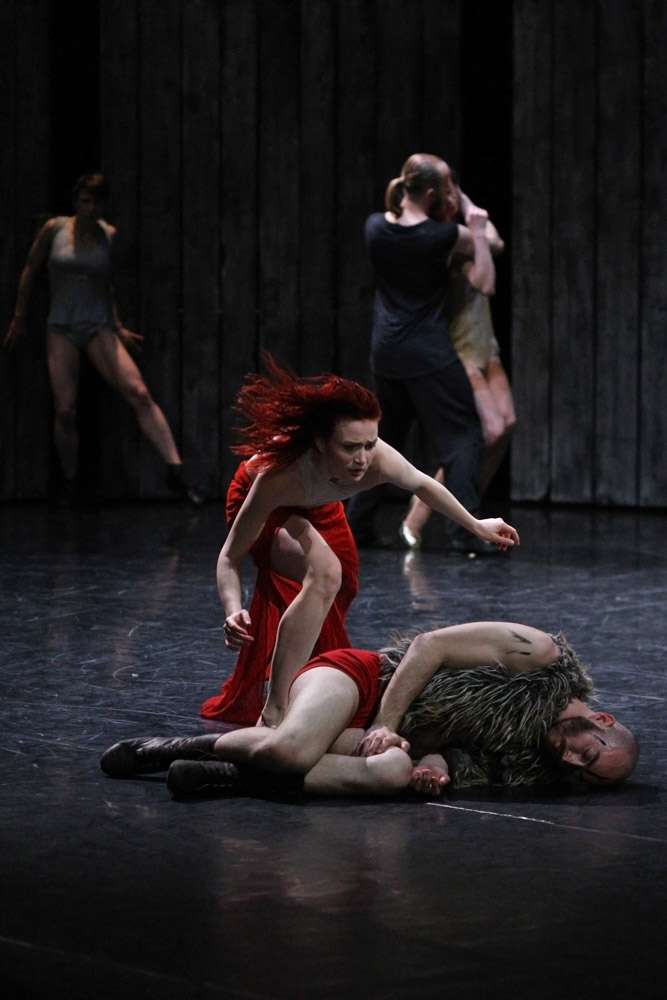
The Tempest by Izadora Weiss.
© K. Mystkowski. (Click image for larger version)
By the third movement, Weiss has reverted to Shakespeare’s Tempest with a storm bringing shipwrecked sailors and nobles from the ‘real’ world. She shows she can choreograph as vividly for sturdy mariners as for tomboyish nymphs in roisterous routines. The first encounter between Miranda and Ferdinand (Oscar Perez Romero) is a lyrical Romeo and Juliet pas de deux of instant attraction. Swept up in Ferdinand’s arms, Miranda is now an adolescent in love, to Prospero’s rage.
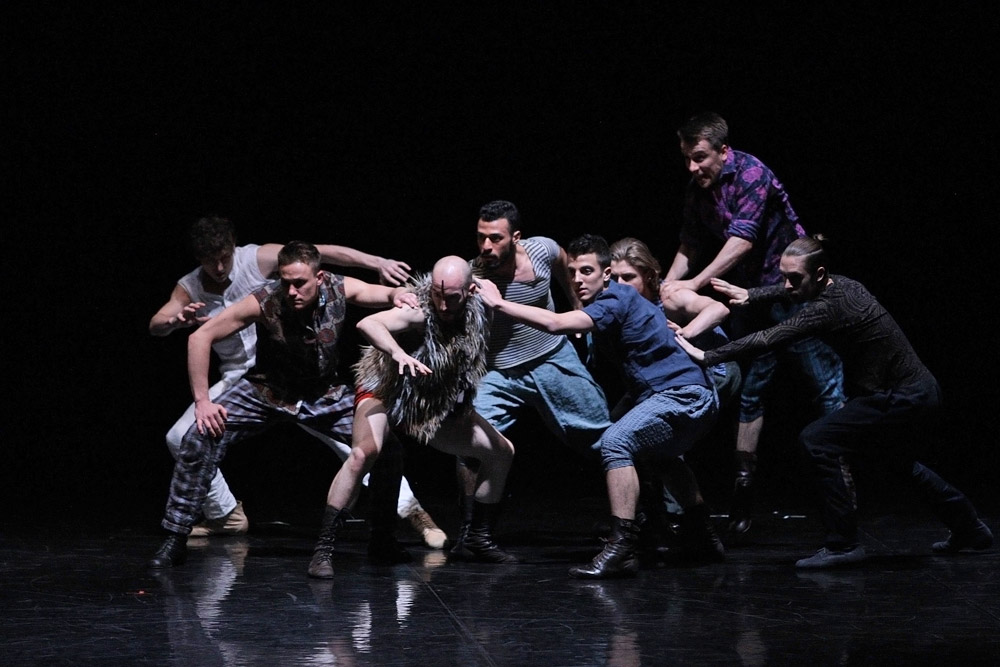
The Tempest by Izadora Weiss.
© K. Mystkowski. (Click image for larger version)
The compressed plot becomes confusing with the intervention of Ferdinand’s father, Prospero’s brother, Juno yet again, and drunken Trinculo and Stefano. Mahler’s music riffs on the French nursery rhyme Frère Jacques as a funeral march while a wedding party is prepared, with the Opera chorus as extras. Since Alonso, King of Naples, presides as a pretentious buffoon, the assembled company’s return to the mainland at the end of the First Symphony does not bode well.
Weiss then departs from Shakespeare’s resolution of the play to depict her vision of Prospero as the conflicted artist who has to accept that he cannot order the world to suit his desires. He has been tied up in a straitjacket by Caliban’s co-conspirators and abandoned. He cannot express his emotions in dance: the adagio from Mahler’s Fifth Symphony has to do it for him.
Ariel remains as the only loyal inhabitant of the island. She releases Prospero from his straitjacket and he removes her clumsy wings. She will now be free to fly as a spirit under her own power. Sweetly and solemnly, she raises a finger in a gesture that appears in several Leonardo da Vinci paintings, indicating a higher knowledge, a link with heaven. She summons Miranda and Ferdinand to dance their love duet with greater maturity than before to Mahler’s swelling music – a reassurance to Prospero that he can let his daughter go.

The Tempest by Izadora Weiss.
© K. Mystkowski. (Click image for larger version)
He is then transfigured by an angel (Beata Giza), who emerges to lead him to another dimension. More balletic than the sprites over whom Prospero has ruled, she puts her hand over his eyes, echoing Balanchine’s angel of death in Serenade. Prospero has met his destiny.
Though the conclusion relies on Mahler’s adagio to deliver the emotional resolution of the work, it is an effective epilogue. Weiss has conveyed her own understanding of Shakespeare’s last play, in which he may have identified himself with Prospero, asking for redemption. She has given her company a range of well-developed roles, creating a distinctive movement style for her main characters and, especially, the female ensemble of nymphs who carry the first part of the production. Tura Gomez Coll is outstanding as Ariel, a fascinating combination of feminine and boyish attributes in her assertive way of dancing. She is entirely persuasive as a mischievous sprite and as a Leonardo angel in touch with another world.

The Tempest by Izadora Weiss.
© K. Mystkowski. (Click image for larger version)
Naya Monzon Alvarez as Miranda makes the most of a role that enables her to progress from a curious youngster to a woman in love with a brave new world. Filip Michalak as her over-protective father reveals his vulnerability beneath his dominance, though I was disconcerted by his lustful relationship with Juno, whose presence bemused me. I had expected Prospero to reach an acceptance of Caliban, but that seems not to be part of Weiss’s plan.
Her response to Mahler’s music is admirably imaginative, tailoring her choreography to suit its danceable rhythms. Her difficulty is the way its four-part structure dictates the pacing of the story, congesting the shipwreck and its consequences into too tight a frame. But her achievement in adapting a difficult play is intriguingly original, in a different league from Glen Tetley’s abysmal Tempest in 1979 for Rambert. Weiss is taking Baltic Dance Theatre on a journey that needs to be seen outside as well as inside Poland.
















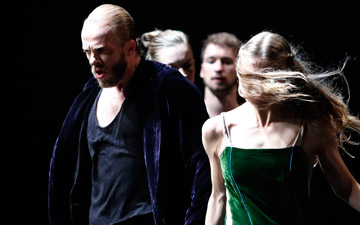
You must be logged in to post a comment.